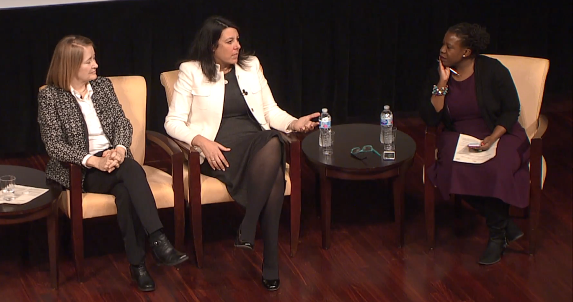
‘One Woman, One Vote’ Anniversary Screening Honors Womens Suffrage Centennial
By Jonathan Marker | National Archives News
WASHINGTON, January 29, 2020 — As part of its celebration of the centennial year of the passage of the 19th Amendment, the National Archives hosted a 25th-anniversary screening of the 1995 PBS film One Woman, One Vote, which documents the struggle for woman suffrage.
Narrated by Susan Sarandon and with a new introduction by U.S. Supreme Court Associate Justice Ruth Bader Ginsburg, the film was produced by Ruth Pollak and co-produced by Felicia Widmann. The screening on January 23, 2020, at the National Archives Building in Washington, DC, was presented in partnership with the One Woman, One Vote Film Festival. The festival brings together national organizations and cultural institutions to present films, concerts, exhibitions, and public events to honor the centennial of the passage of the 19th Amendment.
“Here at the National Archives, our own observance of the centennial includes a series of programs, such as tonight’s screening, and our exhibit in the Lawrence F. O’Brien Gallery upstairs, Rightfully Hers: American Women and the Vote,” Deputy Archivist of the United States Debra Steidel Wall said in her welcoming remarks. “I hope you will visit the Rightfully Hers exhibit—the stories told there of the road to the 19th Amendment and of the women who fought to secure voting rights are well worth learning.”
Wall also shared a new development on behalf of the Women’s Suffrage Commission, on which she is a commissioner, as part of the centennial celebration.
“We have been working with the United States Mint to develop a medal to mark the centennial, and in March we will unveil the designs for this medal in a ceremony hosted by the United States Mint and the Treasury Department,” Wall said.
Wall then honored the memory of a longtime friend of the National Archives, Cokie Roberts, by dedicating the evening’s events to the late journalist, bestselling author, and historian.
“Cokie was a great friend to the National Archives, served on the Board of the National Archives Foundation, and worked tirelessly on behalf of National Archives education and outreach activities,” Wall said. “Over the course of her five-decade career, Cokie documented the stories of countless women in U.S. history. She illuminated their important legacies through her regular appearances on television and public radio, by writing numerous best-selling books, and engaging in spirited discussions about our nation’s heritage.”
During the pre-screening panel discussion, moderator Lottie Joiner, editor-in-chief of The Crisis magazine, was joined onstage by Rebecca Boggs Roberts and Marjorie J. Spruill. Roberts, a journalist, radio show host, and author of Suffragists in Washington DC: The 1913 Parade and the Fight for the Vote, is also the daughter of Cokie Roberts. Spruill is author of Divided We Stand: The Battle Over Women's Rights and Family Values That Polarized American Politics.
Joiner began the discussion with a question to Roberts about her book, asking why she thought the March 3, 1913 parade—which brought over 5,000 suffragists from all over the nation to march down Pennsylvania Avenue in Washington, DC, to rally for their cause—has been forgotten.
“A lot of this history has been forgotten,” Roberts said. “It wasn’t clear until, through the lens of history, what a turning point the parade really was. The parade was ultimately a reintroduction for the push for a Federal amendment, and it was also Alice Paul’s debut in America in terms of introducing more aggressive strategies. Within the context of the movement, it didn’t feel that momentous at the time. Also, the memory was kept by a lot of women whose stories weren’t necessarily paid any attention.”
“What happened to those women in 1913 is just absolutely incredible,” Spruill said. She described the negative response women met from men who had traveled to the nation’s capital to attend a rally for newly elected President Woodrow Wilson the day after the women’s march. “A lot of the men who attended the march in 1913 were not sympathetic [to woman suffrage], and a lot of them that were lining the road had been drinking, and they began to yell things at the women like ‘Go home! . . . Did your husband let you come here?’ and then started throwing bottles at them, and pelting them with lit cigars.”
Spruill said that despite the unrest, Washington, DC, police did not interfere, and the crowd of belligerent men assaulted the women, severely beating many.
There was a silver lining, however.
“Many of the women who got beaten up were the wives and daughters of members of Congress,” Spruill said before pointing out Rightfully Hers exhibit curator Corinne Porter in the crowd. The relevant congressional investigations were among the nearly 100 documents and artifacts Porter used to weave the tapestry of women’s suffrage and tell the stories of the women who fought for their full rights as citizens.
The Rightfully Hers: American Women and the Vote exhibit is on display in the Lawrence F. O’Brien Gallery at the National Archives Museum in Washington, DC, through January 3, 2021.
Find out about upcoming events in the National Archives online calendar.
